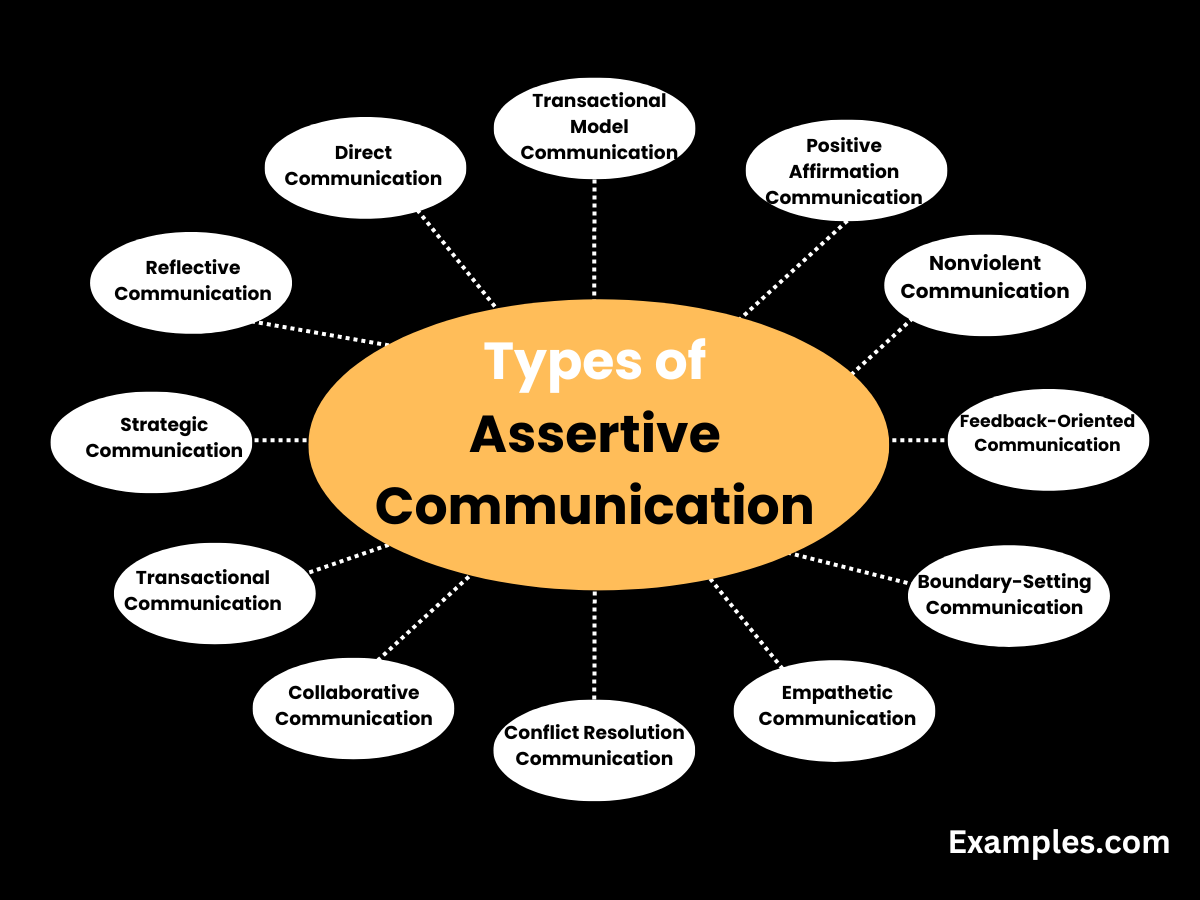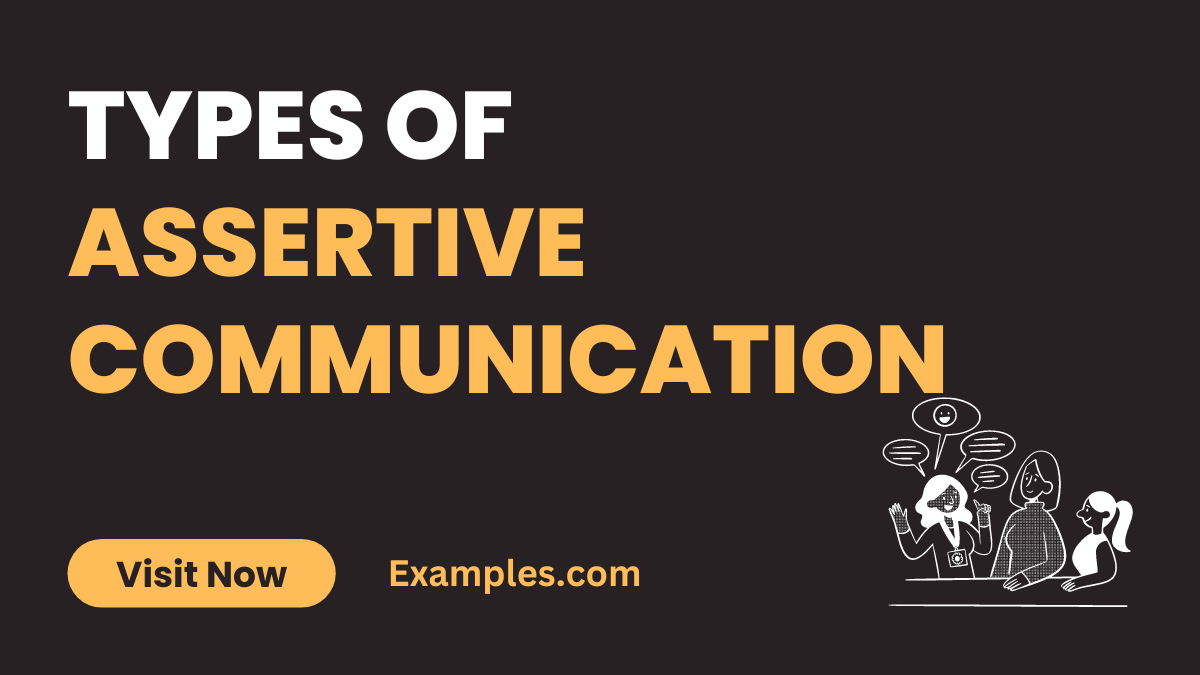Types of Assertive Communication – Examples, Types
Embark on a comprehensive journey through the diverse realm of “Types of Assertive Communication.” Uncover the nuances of assertiveness, explore various communication styles, and grasp key strategies. This SEO-friendly guide delves into practical Communication Examples, offering insights that go beyond theory, empowering you to navigate diverse scenarios with confidence and authenticity. Elevate your interpersonal skills and embrace assertiveness as a powerful tool in your personal and professional interactions.
Types of Assertive Communication
Assertive communication is a multifaceted skill, encompassing various approaches tailored to different scenarios. Let’s delve into the rich landscape of Types of Assertive Communication to equip you with a diverse range of strategies for effective interpersonal interaction.

- Direct Communication: This style is characterized by straightforwardness and clarity, where messages are expressed plainly and explicitly. It avoids ambiguity, making it effective in reducing misunderstandings and ensuring that the communicator’s intentions are clear. Direct communication is particularly valuable in professional settings where clarity is paramount. However, it requires a balance to ensure that directness does not come across as bluntness or insensitivity.
- Reflective Communication: This involves active listening and thoughtful response. Reflective communicators consider what is being said before reacting, often paraphrasing or summarizing the speaker’s message to demonstrate understanding. This approach is crucial in empathetic interactions and counselling, as it helps build trust and understanding between participants.
- Strategic Communication: Strategic communicators plan their messages to achieve specific goals. This involves understanding the audience, crafting clear messages, and choosing the right channels and timing. Strategic communication is often used in marketing, public relations, and leadership to influence, inform, and motivate audiences.
- Transactional Communication: This model views communication as a dynamic process involving a series of exchanges between participants. Each person in the interaction plays the role of both sender and receiver, creating a continuous feedback loop. This approach emphasizes the interdependent nature of communication and its context-dependent quality.
- Collaborative Communication: Focused on teamwork and cooperation, this style is essential in group projects and workplace teams. It involves open sharing of ideas, active listening, and consensus-building. Collaborative communication is key to fostering a productive and harmonious working environment.
- Conflict Resolution Communication: This style is used to manage and resolve disputes. It involves skills like negotiation, compromise, and understanding different perspectives. Effective conflict resolution communication is essential for maintaining positive relationships in both personal and professional contexts.
- Empathetic Communication: Involves understanding and sharing the feelings of another person. This approach is key in building close personal relationships, as well as in caregiving professions. It requires active listening, validation of others’ feelings, and responding with compassion and understanding.
- Boundary-Setting Communication: This style is about expressing personal limits and expectations clearly. It’s crucial for maintaining healthy relationships and self-respect. Effective boundary-setting involves clear, direct communication and the ability to assert one’s needs respectfully.
- Positive Affirmation Communication: Involves using positive statements or affirmations to foster positive thinking and self-empowerment. This approach can improve self-esteem, motivation, and overall mental well-being.
- Transactional Model Communication: A comprehensive model that views communication as a dynamic and interactive process influenced by multiple factors, including the communicators, their environment, and the context. This model acknowledges that communication is not just about sending and receiving messages but also involves interpretation and feedback.
- Visual Communication: This style uses visual elements like images, graphics, and videos to convey information. It’s effective in capturing attention, enhancing understanding, and facilitating memory retention. Visual communication is widely used in education, advertising, and digital media.
- Intrapersonal Communication: Refers to the communication that occurs within an individual. This includes thoughts, self-talk, and internal processing of information. Intrapersonal communication is fundamental to self-awareness, decision-making, and personal development.
- Interpersonal Communication: Involves direct, face-to-face communication between individuals. It’s the cornerstone of building relationships and includes verbal and nonverbal elements. Effective interpersonal communication requires skills like active listening, empathy, and adaptability.
- around the exchange of constructive feedback. This approach is essential in educational and professional development settings. It involves giving and receiving feedback in a way that promotes learning and improvement.
- Nonviolent Communication: Developed by Marshall Rosenberg, this approach emphasizes compassion and collaboration in communication. It aims to resolve conflicts peacefully and build mutual understanding. The key components include observing without evaluating, expressing feelings and needs, and making requests rather than demands.
- Therapeutic Communication: Used primarily in healthcare and counselling settings, this approach aims to support and heal. It involves listening, empathy, encouragement, and providing emotional support in a non-judgmental way.
- Crisis Communication: Involves managing communication before, during, and after a crisis. Effective crisis communication is crucial for minimizing harm, maintaining trust, and restoring normalcy. It requires clarity, honesty, and timely dissemination of information.
- Persuasive Communication: Aims to influence or change the audience’s attitudes, beliefs, or actions. This style is widely used in advertising, politics, and sales. It involves understanding the audience’s needs and preferences and presenting arguments compellingly.
- Transactional Communication: This communication model views interactions as dynamic exchanges where each participant is both a sender and a receiver. Unlike linear models, transactional communication recognizes the continuous flow and impact of feedback, context, and individual experiences. It emphasizes that communication is not a one-way process but a complex, interactive activity where all parties influence the outcome. Effective transactional communication requires active listening, adaptability, and awareness of non-verbal cues. It is widely applicable, from personal conversations to professional settings, facilitating a deeper understanding of the reciprocal nature of communication.
Adaptive Communication: Adaptive Communication is the skill of altering communication methods and styles to suit different situations, audiences, and contexts. This flexible approach is vital in a world marked by cultural diversity and varying communication needs. It involves understanding different communication styles, recognizing cultural nuances, and choosing the most effective way to convey messages. Adaptive communicators are skilled at reading their audience, whether in personal relationships, multicultural environments, or professional settings, and adjusting their tone, language, and non-verbal cues accordingly. It’s a key skill for leaders, educators, and anyone working in diverse teams or global settings.
In conclusion, the exploration of various types of assertive communication reveals its indispensable role in both personal and professional settings. Assertiveness is not just about being heard; it’s a balanced approach that respects both personal boundaries and those of others. It serves as a bridge between passive and aggressive styles, offering a middle ground where everyone’s needs and opinions are acknowledged and respected. This approach leads to healthier interactions, reduced misunderstandings, and more productive communication in all aspects of life.
In personal development, assertiveness is a gateway to self-empowerment. It helps individuals to clearly express their needs and opinions while respecting others, fostering a sense of self-respect and mutual understanding. This can lead to improved relationships, enhanced decision-making skills, and an overall sense of personal fulfilment. Learning to be assertive is a journey of self-discovery and growth, with benefits that extend into all facets of an individual’s life. For comprehensive insights into the importance of assertive communication in personal growth, the Mayo Clinic offers valuable resources and guidance. You can learn more by visiting the Mayo Clinic’s page on assertive communication.
Professionally, assertive communication is equally vital. It enhances workplace dynamics by promoting a culture of mutual respect and open communication. This approach encourages a free exchange of ideas, boosting creativity and productivity. It also empowers individuals to make independent decisions, contributing to personal and organizational growth. In environments where assertiveness is encouraged, employees are less likely to experience stress, resentment, or burnout, leading to a more positive and productive workplace atmosphere. For an in-depth understanding of the benefits of assertive communication in professional settings, VIWELL provides a detailed exploration of its advantages and applications in the workplace. To explore these benefits further, you can visit VIWELL’s article on assertive communication in the workplace.



